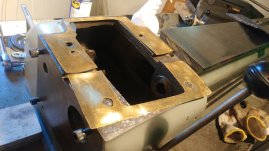max.levesque
Aluminum
- Joined
- Aug 31, 2007
- Location
- Sherbrooke
I removed the headstock of my newly aquired 1956 Hardinge HLV-BK, and there was a 0.1mm brass shim between it and the bed.
I've read about many instances of elevating the tailstock after a bed grind, can't think of a reason to elevate a headstock, other than wanting to align to an elevated tailstock, but what in the world would elevate a tailstock ?
Unfortunately I haven't measured the spindle to tailstock alignment before removing the headstock (nor before buying), that information might have provided some explanation as to why the shim is there.
I'm going to put it back without the shim, put a dead center in the tailstock, and see how it aligns to a pin held by a 5c collet.
If the tailstock happens to be 0.1mm higher, it will explain the shim, if the heights turns out equal or lower, then I will be even more puzzled !
I've read about many instances of elevating the tailstock after a bed grind, can't think of a reason to elevate a headstock, other than wanting to align to an elevated tailstock, but what in the world would elevate a tailstock ?
Unfortunately I haven't measured the spindle to tailstock alignment before removing the headstock (nor before buying), that information might have provided some explanation as to why the shim is there.
I'm going to put it back without the shim, put a dead center in the tailstock, and see how it aligns to a pin held by a 5c collet.
If the tailstock happens to be 0.1mm higher, it will explain the shim, if the heights turns out equal or lower, then I will be even more puzzled !



